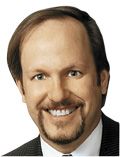Article
Men’s health: The argument for a holistic approach
Steven A. Kaplan, MD, introduces #LetsTalkMensHealth, a novel new section in Urology Times focused on men’s health.

Over the past decade, we have begun to hear new terms to describe how we should categorize health care delivery. Among those terms are personalized health, eg, genomics, pharmacokinetics, and gender care (ie, women’s and men’s health). They all sound sophisticated and very 21st century, but what do they really mean to the average practitioner and patient? More specifically, urologists have become increasingly interested in men’s health. Not surprisingly, this has met with some skepticism as a branding effort rather than a new paradigm of health care delivery.
But is there an opportunity for the specialty of urology to refocus our educational and practice efforts to a more holistic approach that caters to the needs of men? I would enthusiastically answer, yes! Moreover, if we don’t, urology is in danger of falling behind as an optimized specialty in health care delivery for men.
To that end, Urology Times has embarked on the development of #LetsTalkMensHealth, a novel new section focused on men’s health, and I am excited to act as the lead of this endeavor. So what is men’s health and why now?
Why men’s health now?
Patients who suffer from various aspects of metabolic dysfunction are overwhelming the health care system. In large part, this is due to the crisis of obesity, which is related and secondary to decreased exercise, poor diet, and the cumulative effects of environmental stress. Obesity is an enormous public health problem in the U.S. and worldwide, and is associated with numerous comorbid illnesses and chronic conditions. This is coupled with escalating cost and significantly impacts the quality of life in affected individuals.
Chronic diseases associated with obesity include type 2 diabetes, heart disease, sleep disorders, musculoskeletal pain disorders, and cancers of the colon, esophagus, gallbladder, and kidneys. Type 2 diabetes is approximately four times more prevalent among obese men, and twice as many have high cholesterol or heart disease compared to normal-weight men.
Moreover, associated urologic disorders, including benign prostatic hyperplasia, hypogonadism, erectile dysfunction, prostatitis, and nocturia are all more common in obese men.
These findings represent an important entry portal for urology and urologic care. We have to start thinking above the waist in a systematic function to bring greater value to the health care system at large.
In other words, men’s health should focus on the unique health needs and accompanying services that must be implemented to address this phenomenon. Chief among these needs is a gender–specific approach (this applies to women’s health as well) that encompasses and affects change in research, advocacy, government policy, and allocation of resources. Ultimately, this is all designed to optimize health services delivery.
In a previous summary of the topic, Elterman et al summarized the concept of the leadership role of the urologic community: “We need to be at the forefront in defining the issues, ‘connecting the dots,’ collaborating with stakeholders to create initiatives, and integrating those practices into the field in order to broaden the definition of the Urologist as the Men’s Health physician” (Nat Rev Urol 2013; 10:606–12).
Next: Focus has been on specific organs rather than holistic approach
As a specialty, we have become more and more focused on specific urologic organs rather than a comprehensive, holistic approach. Not surprisingly, men’s health has followed that route, depending on who is driving the message. It may be urology (ie, prostate cancer and sexual health) or internal medicine (ie, cardiovascular and metabolic health).
We recognize that male mortality rates across all age groups have been consistently higher than those of age-matched females. Currently, men live on average 6 years less than women (Aging Clin Exp Res 2008; 20:91-102). In addition, quality of life decreases quantitatively more for men than women; ie, men will spend their latter years in poorer health compared to age-matched women.
In general, men seek health care professionals almost 25% less than women. In large part, this is secondary to social norms, that is, men are tougher and should endure. Not surprisingly, these traits are associated with unhealthy behaviors such as poor diet, excess alcohol consumption, smoking, and high-risk activities (Soc Sci Med 2006; 62:387-95; J Health Psychol 2009; 14:1047-58; Soc Sci Med 2006; 63:2476-88). As noted by Pelman et al, these areas represent a target for the urologist to educate, prevent, intervene, or refer on to another health care professional (AUA Committee on Male Health. White paper: “Male Health-Urology’s Collaborative Future.” Presented at AUA Board of Directors meeting, 2010).
That is where the focus will be in this new section on men’s health. Our invited authors will share evidence-based goals for intervention, with focus on economic factors and barriers to accessing health care by men and creating new means for men to engage.
Men’s health centers emerge
Men’s health centers are beginning to emerge across the United States and Europe. Some are geared toward sexual health and often (unfortunately) as a branding tool rather than as a comprehensive preventive, diagnostic, and therapeutic center. Our group was part of the first comprehensive center in New York, the Iris Cantor Men’s Health Center, which incorporates a multispecialty group led by urology and also consisting of cardiology, endocrinology, and primary care medicine. We are evidence that the concept works, as we have been very successful in patient engagement and have surpassed all our subjective and objective measures within the first year.
Why not replicate this for urologists across the country? Furthermore, now is the time.
Numerous government and insurance domains have accepted, advocated, and funded initiatives in gender health. This includes creation of the International Society for Male Health, established at the first World Congress on Men’s Health in Vienna in 2001. Numerous countries including the U.S., Canada, Australia, and several in Europe have established, funded, and advocated multidisciplinary centers for excellence in men’s health. These ideas and concepts are best described by the group in Australia, which defined six priority areas:
- optimize health outcomes for men
- promote health equity between groups of men
- create strategies for health improvement for men at different life stages
- focus on prevention
- build the evidence base for future policy
- improve access to care (Nat Rev Urol 2013; 10:606–12; Australian Government Department of Health and Ageing, 2010 [http://ow.ly/AitDI]).
A vision for urology
Ultimately, the vision for urology should be to lead men’s health, setting the policy and research agenda by ensuring urologists remain at the forefront of providing specialty care for men’s health needs. Moving forward, the urologist will be the authority and coordinator of care for men navigating through the health care system. In an era of telemedicine, digital informatics, and preventive care, we can take a foothold at leading health care institutions and providers in delivering quality, information, and trust. This is especially true given that many of the most common conditions for which men enter the health care system are via urologic portals, ie, the symptoms of voiding and sexual dysfunction and cancer screening.
Urologists and their professional organizations must take ownership in educating, advocating, and delivering the best information and care to their members, professional collaborators, and the general public on the urology-specific and non-urologic health issues facing men.
So where is medicine heading in the future, and specifically, where can urology drive a stake in the ground to maintain and even increase its role in heath care delivery? We need to think beyond our historic role as pelvic care specialists and take a much more holistic, patient-oriented, and gender-based approach in all aspects of our specialty. This includes education, research, advocacy, and patient care. This should begin with training medical students, residents, and fellows and sharing this knowledge with current practicing urologists and our related peers.
Conclusion
We are in a prime position to lead this initiative but it will require bold vision, resources, and most important, commitment. We have a unique opportunity to help improve the quality of health care delivery for men in a more efficient, comprehensive, and scalable fashion. Men’s health can be and should be incorporated into existing models of clinical practice. Otherwise, we will ultimately fulfill the prophecy of one of our forefathers in urology, Paul Peters, MD, who predicted that urologists would “once again become clap doctors.”
We can do better, we should do better, we must do better. Let’s take a bold, fresh, and determined pathway and lead in improving the lives of men throughout the world.UT
Subscribe to Urology Times to get monthly news from the leading news source for urologists.















